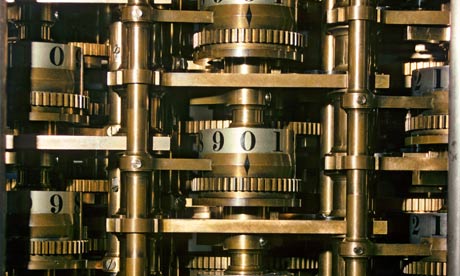
Science fiction dates rapidly. Pity the forward-thinking speculative fiction author of 1990. The world was embarking on the final decade of the millennium and there were all kinds of new and interesting things occurring, especially in Britain, that hinted at change: the end of Margaret Thatcher's 11-year reign; a classic youth-cult moral panic over acid house; the need for a Computer Misuse Act to tackle the brave new world of hacking.
But only the most broad-minded of writers could have envisaged what was going to happen over the next decade or so – developments that included, but weren't limited to, the rise of the internet, the stranglehold of reality television, and of course the grimly world-altering terrorist attacks of 2001 .
Perhaps that's why one of the SF books of 1990 that continues to stand out was looking not towards a future that was impossible to predict, but backwards. The book was The Difference Engine by William Gibson and Bruce Sterling, and although it wasn't the first book in the sub-genre that became known as steampunk, it's certainly the one credited with cementing and formalising it. Set in the mid-19th century, the novel posited an alternate history dating from 1825, at which point, for the purposes of Gibson and Sterling's fictional world, Charles Babbage's theoretical work with proto-computers was successful. As a result, there is a Technological Revolution to match the Industrial one, and a world in which steam-powered analytical engines fuel endless innovations comes into being.
Steampunk is a riff on the cyberpunk genre, which came to prominence in 1984 with William Gibson's Neuromancer. Apart from a catchy name, though, steampunk doesn't appear to share a great deal with cyberpunk's hi-tech, near-future, noirish milieu. In steampunk, the backdrop is usually 19th-century England, specifically Victorian-era London. But this is Victoriana with knobs on: common steampunk tropes include advanced technology within the parameters of what was reasonably do-able at the time. Steam-powered vehicles trundle alongside clockwork automata, dirigibles and crude Babbage-style computing devices, with real and fictional figures of the age participating in adventures. The original steampunk practitioners are widely regarded to be KW Jeter, author of Morlock Night and Infernal Devices, James P Blaylock, who wrote Homunculus, and Tim Powers, with The Anubis Gates (recently brought to the attention of Guardian blog readers by Alison Flood), which were all released between 1979 and 1987. And Michael Moorcock, as early as his 1971 novel The Warlord of the Air, part of his Eternal Champion tapestry, was utilising many of the Victorian elements of steampunk.
It could be argued – and people have – that the 19th century was quite exciting enough without these speculative bolt-ons, but nevertheless, 20 years after The Difference Engine was published, it appears to be back with a vengeance. Two recent anthologies – Steampunk, edited by Jeff and Ann Vandermeer, and Extraordinary Engines, from Solaris Books – whetted genre fans' appetites, and steampunkish novels are following at a rapid rate: Stephen Hunt's series of books that began with the Court of the Air; Dan Simmons' literary fantasy Drood, in which Charles Dickens begins to suspect the hero of his unfinished novel is up to no good; and George Mann's Affinity Bridge novels all spring quickly to mind.
As with many things from Britain's colourful past, steampunk has also captured the hearts of many American writers, who sometimes work within the "alternative London" framework or expand the steampunk horizons – witness Cherie Priest's Boneshaker, in which Seattle falls to a fin-de-siecle zombie plague, and Jay Lake's Mainspring, starting off in Boston.
The concept has also moved beyond its literary origins. Alan Moore's well-received comic series The League of Extraordinary Gentlemen (later made into a movie, not so well-received) is classic steampunk, and there is an industry devoted to creating steampunked art and contraptions and even clothing.
Why steampunk is back is hard to say. Perhaps it offers what SF could be starting to lose – a sense of wonder and, more importantly, the opportunity for a bit of fun. As we barrel forward towards our science fiction future (2010 already – didn't Arthur C Clarke have us flying to the far reaches of the solar system by now?) the long-range ideas of the genre's past practitioners – primarily climate change and the prospect of humanity wiping itself out – now seem more like certainties than ever before. Bleak visions such as Cormac McCarthy's The Road seem a lot more likely than holidays on the moon and jetpack commutes to work.
If the future looks dim, perhaps we can't be blamed for looking to reinvent the past, which thanks to steampunk often looks so bright that we might have to wear shades – or at least a nice pair of steampunkish aeronautical goggles.

